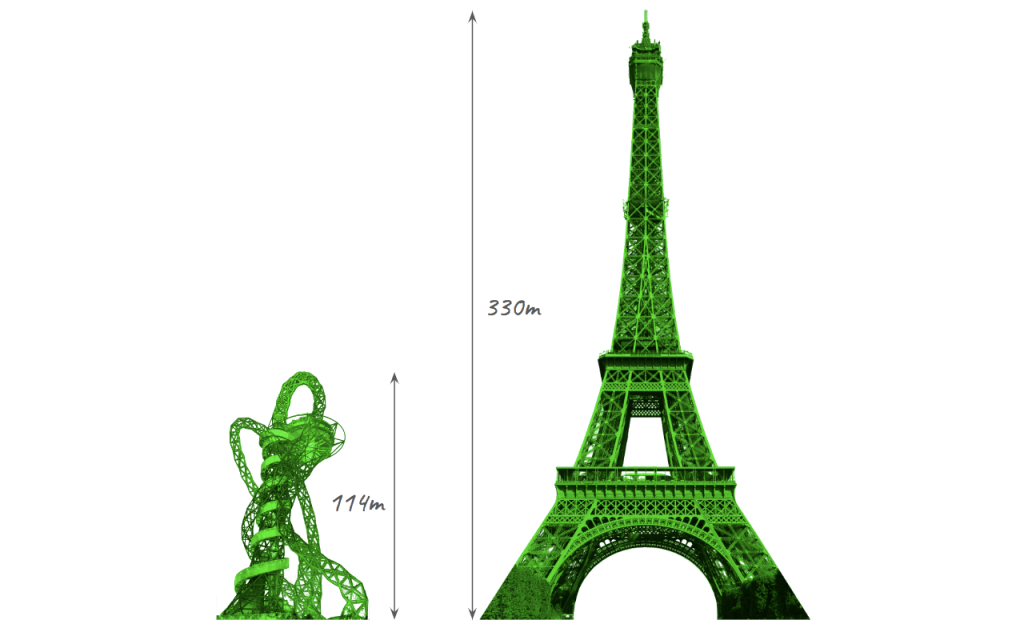If you design buildings for a living you spend a lot of time thinking about what makes a good building. Which buildings do people most enjoy being in ? Which buildings are people most proud of ? Which buildings use materials most efficiently ? I remember an ex-colleague who was a structural engineer who liked to argue that the best buildings had a unique silhouette. So by that measure these are two strong contenders the ArcelorMittal London Orbit in the Olympic Park in Stratford, London in England vs the Eiffel Tower on the Champs du Mars in Paris, France.
The Eiffel Tower is the oldest. It was built for the 1889 World’s Fair in Paris. Eiffel’s company developed the design which they submitted to a competition. They won and were granted 1.5 million francs to construct it (less than a quarter of the estimated cost). He paid the remainder of the construction cost himself in return for the proceeds from it’s receipts for the first twenty years of its operation.
The ArcelorMittal Orbit is much more recent. It was built for the 2012 Olympics in London. A competition was run for an Olympic Tower. The winning design was by Anish Kapoor (a sculptor) and Cecil Balmond (an engineer at Arup). The London Development Agency provided £3.1m funding (less than a sixth of the estimated cost). The remainder was paid by ArcelorMittal (a steel company) who constructed the tower.
Each tower has two observation decks. They also have their own distinctive features. The Eiffel Tower is one of only two known buildings in the world to have an elevator on an incline (the other is in the town hall in Hannover, Germany). The ArcelorMittal Orbit has what is believed to be the longest tunnel slide in the world which is 178m long.

The Eiffel Tower is 330m tall. Before it was built the tallest free-standing structure in the world was the Washington Monument which is 169m high. It is constructed of wrought iron. Wrought iron was a precursor to steel, it has some strength in tension but is anisotropic (formed in layers) and the failure stress is very variable. The Eiffel Tower’s shape is similar to a pyramid, which is a very efficient shape adorned with pediments and the arch for aesthetic flourishes. It is believed to have been analysed using integrals and graphic analysis carried out by hand. The structure weighs 7,300 tonnes which is equivalent to 22 tonnes/m height. The additional elements such as lifts, shops and antennae bring the total weight to 10,100 tonnes.
The London Orbit is 114m tall built of steel. The shape was designed to use “instabilities as stabilities”. It would not have been possible to build using wrought iron as the reliable strength is lower than modern steel. The required quantities of materials could not have been reasonably calculated without modern advances in computer analysis. The overall shape is irregular and unbalanced which requires more structural materials for a given height. The structures has approximately 2,000 tonnes of steel, which is equivalent to 17.5 tonnes/m height. Some crude approximations suggest that this could have been reduced by about half if a more efficient shape had been chosen.
structural engineer buildings Eiffel Tower London Orbit structural engineer buildings Eiffel Tower London Orbit structural engineer buildings Eiffel Tower London Orbit structural engineer buildings Eiffel Tower London Orbit structural engineer buildings Eiffel Tower London Orbit structural engineer buildings Eiffel Tower London Orbit structural engineer buildings Eiffel Tower London Orbit structural engineer buildings Eiffel Tower London Orbit structural engineer buildings Eiffel Tower London Orbit structural engineer buildings Eiffel Tower London Orbit structural engineer buildings Eiffel Tower London Orbit structural engineer buildings Eiffel Tower London Orbit structural engineer buildings Eiffel Tower London Orbit


